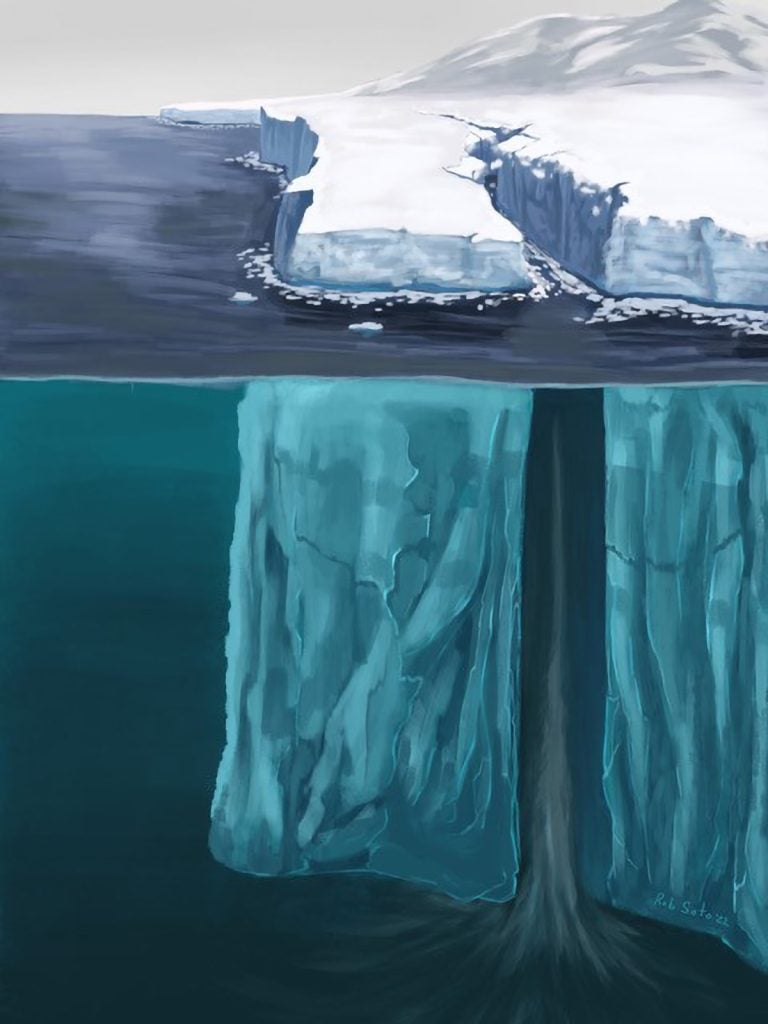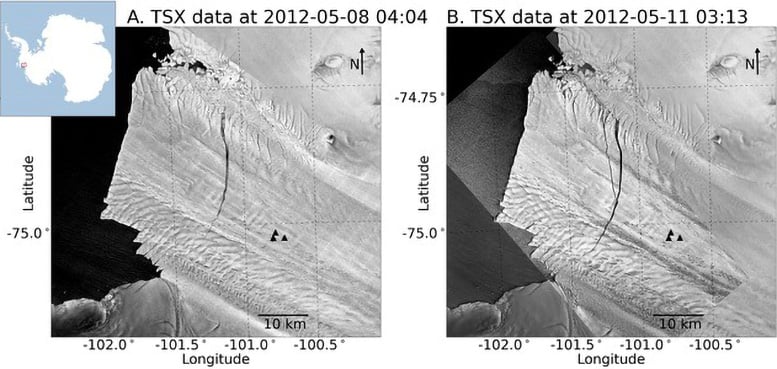

In this illustration, seawater flows deep below the surface into an actively opening ice shelf crack in Antarctica. New research shows that such cracks can open very quickly, and that flowing seawater helps control how quickly the ice shelf breaks. Credit: Rob Soto
There is enough frozen water in the glaciers of Greenland and Antarctica that, if they melted, the world's seas would rise several feet. What will happen to these glaciers over the coming decades is the biggest unknown in the future of rising sea levels, partly because the physics of glacier calving is not yet fully understood.
The crucial question is how warmer oceans can cause glaciers to disintegrate more quickly. University of Washington Researchers have demonstrated the fastest large-scale fracture known along the Antarctic ice shelf. The study was recently published in Provided by the Arabian Gulf UniversityIt shows that a 6.5-mile-long (10.5-kilometer) crack formed in 2012 on the Pine Island Glacier — a retreating ice shelf holding back the larger West Antarctic ice sheet — in about 5 1/2 minutes. This means the crack opened at a speed of about 115 feet (35 meters) per second, or about 80 miles per hour.
“This to our knowledge is the fastest rift opening event ever observed,” said lead author Stephanie Olinger, who did this work as part of her doctoral research at the University of Wisconsin and Harvard University and is now a postdoctoral researcher at Stanford University. . “This shows that, under certain conditions, ice shelves can break. It tells us that we need to look for this kind of behavior in the future, and it tells us how we can go about describing these fractures in large-scale ice sheet models.”
The importance of crack formation
The crevasse is a crack that runs through approximately 1,000 feet (300 m) of floating ice of a typical Antarctic ice shelf. These cracks are a precursor to ice shelf calving, where large chunks of ice break off from a glacier and fall into the sea. Such events often occur at Pine Island Glacier, where the iceberg observed in the study has long separated from the continent.

Satellite images taken on May 8 (left) and May 11 (right), three days apart in 2012, show a new fault forming a “Y” branching off to the left of the previous fault. Three seismic instruments (black triangles) recorded vibrations that were used to calculate fault propagation speeds up to 80 mph. Credit: Olinger et al./AGU Advances
“The ice shelves exert an important influence on the stability of the rest of the Antarctic ice sheet. “If the ice shelf breaks, the ice behind it actually accelerates,” Ollinger said. “This process of fracturing is basically the way Antarctic ice shelves work.” Creating large icebergs.
In other parts of Antarctica, faults often develop over months or years. But it could happen more quickly in a rapidly evolving environment like the Pine Island Glacier, where researchers believe the West Antarctica ice sheet has already formed. A turning point has passed When it collapses into the ocean.
Challenges in monitoring glacial changes
Satellite images provide continuous feedback. But satellites orbiting the Earth pass every point on Earth only every three days. It is difficult to determine what happens during those three days, especially given the dangerous sight of the fragile Antarctic ice shelf.
In the new study, the researchers combined tools to understand fault formation. They used seismic data recorded by instruments placed on the ice shelf by other researchers in 2012 along with radar observations from satellites.
Glacial ice behaves like a solid over short timescales, but more like a viscous liquid over long timescales.
“Is the formation of a crack more like breaking glass or more like breaking up Silly Putty? That was the question,” Ollinger said. “Our calculations of this event show that it is very similar to breaking glass.”
The role of seawater and future research
If the ice were a simple brittle material, it would have broken down faster, Olinger said. Further investigation pointed to the role of seawater. Seawater in the crevasses keeps the space open against the inland forces of the glacier. Since seawater has viscosity, surface tension, and mass, it cannot fill a void instantly. Instead, the speed with which seawater fills the opening fissure helps slow the crack's propagation.
“Before we can improve the performance of large-scale ice sheet models and forecasts of future sea level rise, we must have a good physics-based understanding of the many different processes that influence ice shelf stability,” Olinger said.
Reference: “Oceanic coupling limits rupture velocity for the fastest ice shelf crack propagation event” by Stephanie D. Olinger, and Bradley B. Lipofsky, and Maren A. Denol, February 05, 2024, Provided by the Arabian Gulf University.
doi: 10.1029/2023AV001023
The research was funded by the National Science Foundation. Co-authors are Brad Lipofsky and Marine Degnole, both UW faculty members in earth and space sciences, who began advising work while at Harvard.

“Web maven. Infuriatingly humble beer geek. Bacon fanatic. Typical creator. Music expert.”





More Stories
Scientists confirm that monkeys do not have time to write Shakespeare: ScienceAlert
SpaceX launches 23 Starlink satellites from Florida (video and photos)
A new 3D map reveals strange, glowing filaments surrounding the supernova